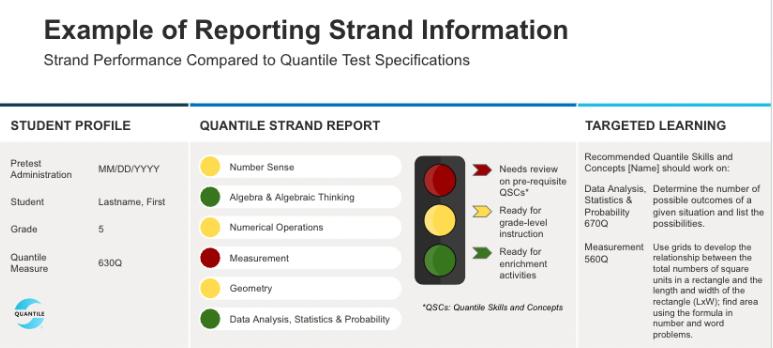Reporting Quantile Student Measures for Students and Materials
Quantile measures for students and materials are reported as a number followed by a capital “Q.” There is no space between the measure and the “Q” and measures of one thousand or greater are reported without a comma (e.g., 1050Q). All student Quantile measures are rounded to the nearest 5Q to avoid over-interpretation of the measures.
- A computed Quantile measure is 772, it should be reported as 770Q.
- A computed Quantile measure is 777, it should be reported as 775Q.
The measures that are reported for an individual student should reflect the purpose for which they will be used. If the purpose is accountability (at the student, school, or district level), then actual measures should be reported at all score points. If the purpose is instructional, then the scores should be capped at the upper bound of measurement error (e.g., at the 99th percentile point). In an instructional environment where the purpose of the Quantile measure is to appropriately match learners with math material, no student should receive a negative measure. Therefore Quantile measures of 0Q or below are reported as “EM” for “Emerging Mathematician.”
This table provides reporting caps by grade and course:
| Grade | Quantile | Math Course |
|---|---|---|
| Lowest |
EM400 |
|
| K | 600Q | |
| 1 | 675Q | |
| 2 |
725Q |
|
| 3 |
975Q |
|
| 4 |
1075Q |
|
| 5 |
1125Q |
|
| 6 |
1200Q |
|
| 7 |
1325Q |
|
| 8 |
1450Q |
|
| 9 |
1475Q |
Algebra I |
| 10 | 1500Q | Geometry |
| 11 | 1575Q | Algebra II |
| 12 | 1650Q |
Some assessments report a Quantile range of 50Q above and 50Q below the student’s actual Quantile measure. The Quantile range takes into account any measurement error found in the tests and the Quantile measures of the skills/concepts. If a student attempts material above his or her Quantile range, the level of challenge may be too great for the student to be able to construct an understanding of the skill or concept. Likewise, the material below the student’s Quantile range may provide the student with little challenge.
All Quantile measures for mathematics materials are rounded to the nearest 10Q. Measures range from below 0Q (e.g., EM50Q) for beginning mathematics materials to above 1600Q for advanced materials. For materials with Quantile measures below 0Q, the negative sign is replaced with an “EM” code indicating that these are “Emerging Mathematics” materials.
Quantile Strand Reporting
In addition to reporting a Quantile measure for a student, assessments can provide more granular information about a student’s performance in six areas of math. Quantile strand-level data provides educators with detailed insights to help inform instruction.
Quantile strand-level reporting is possible because of the inherent structure in the Quantile Framework. The building blocks of the Quantile Framework are the Quantile Skills and Concepts (QSCs), which represent specific mathematical skills and concepts that span the mathematics curriculum from Kindergarten through Calculus and Statistics. The QSCs are organized into strands, which are major subdivisions of mathematical content. The Quantile Framework comprises six mathematical strands, including Algebra & Algebraic Thinking, Number Sense, Numerical Operations, Measurement, Geometry, and Data Analysis, Statistics & Probability.
Quantile strands provide enhanced reporting options with feedback about a student’s performance across these six strands of mathematics. This targeted assessment information can be added to score reports and used to help tailor instruction and effectively close learning gaps, ensuring every student can achieve their full potential.
- Exams must contain 30+ items for grades K–1 and 45+ items for grades 2–12.
- Each strand must contain a minimum of 6 items.
- Items must be assigned to a single strand.
Additionally, the default strands used to create a Quantile assessment are defined as the six Quantile Framework strands; however, customized strand definitions may also be an option depending on your exam or curriculum.
An overall Quantile measure will continue to be reported based on a student’s performance for the entire Quantile exam. While a numeric Quantile value is provided for each strand, this strand-level data is reported in a qualitative or descriptive (i.e., non-numeric) format. For example, in the report below, the strand-level data is reported as red for needs review, yellow for grade-level readiness, and green for enrichment activities recommended.
For companies who have worked with us to report student Quantile measures, we can evaluate your existing assessments to determine how strand-level reporting can be implemented.
Or, you can partner with us to develop a Quantile-powered mathematics assessment from the ground up, and strand-level reporting will be built in.
Reporting Strand Information
Partners utilize the MetaMetrics® Scoring Service API to receive Quantile measures for each strand. The Quantile measures are used to inform graphical or categorical reporting of the information. MetaMetrics will work with each partner to determine the best way to descriptively display the Quantile strand-level information within their reporting system.

